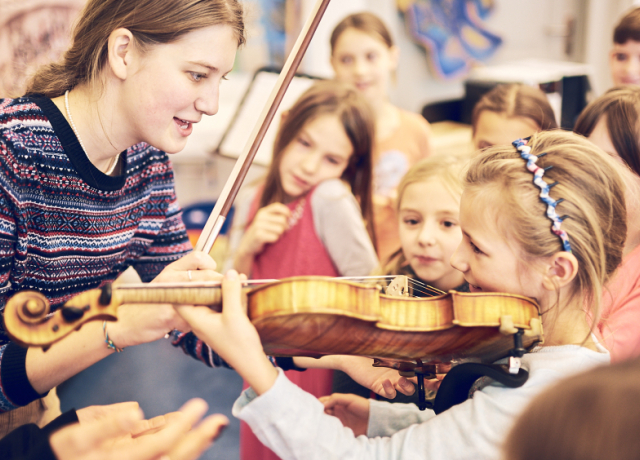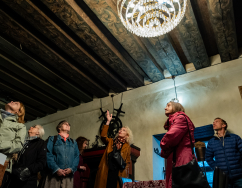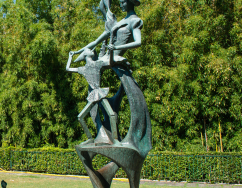European Heritage Days Article:
Exploring Europe's Artistic Legacy: Cultural Connections through Art, Music, and Architecture
European Heritage Days Article:
Exploring Europe's Artistic Legacy: Cultural Connections through Art, Music, and Architecture
Photo: European Music Trails in Leipzig (credit, Leipziger Notenspur)
This article explores how this year's celebrations can delve into aspects of shared artistic heritage, offering ideas for events ranging from performances to guided tours, inspired by everything from antiquity to the modern era.
European Architectural Tours: Discovering the Continent’s Diverse Styles
The artistic connections of Europe can be seen all around us through the architecture of towns and cities. Guided tours with local specialists could highlight buildings featuring different architectural styles or those built by architects who worked internationally. Thematic examples can be found in the Cultural Routes of the Council of Europe which particularly highlight the 19th century Art Nouveau movement and the work of Le Corbusier and Alvar Aalto as pioneers of modern architecture. More historic architectural connections could also be assessed through the influence of classical styles such as those with Roman or Greek origins, while the spread of these aesthetics could also be considered by examining early tourism routes such as the 17th and 18th century tradition of the Grand Tour in which travel across the continent provided education about antiquity and the Renaissance. Another angle for architectural events could be based in aspects of urban planning or the development of infrastructure networks. For example, one of the European Heritage Days Stories in 2022 looked at the work of Victorian architect, Samuel Morton Peto and how he helped to join the English seaside town of Lowestoft to the rest of the UK by rail and internationally as a trade hub by developing the harbour to boost commerce with Denmark. Other events could focus on shared design features, taking inspiration from organisations such as the European Walled Towns Association which aims to preserve, sustainably develop and promote the mutual interests of its network of historic towns.
The sound of Europe: Celebrating Cross-Country Influences
Musical heritage can trace its influences across Europe as many classical musicians travelled widely for patronage and to perform. One example which shows how this concept could be interpreted by events are the European Music Trails from the European Heritage Days Stories initiative. This project celebrated the work of European composers whose visited and worked in Leipzig, with music trails through the city, school workshops and a touring exhibition. A series of events also considered how the experiences of composers during their time in Germany contributed to the musical development in their home countries, and aimed to highlight the uniting power of music by hosting concerts with young musicians from Norway and Lithuania. Another idea for events could focus on the work of a particular person to consider how their travels contributed to the spread of musical styles and helped to create a shared European identity. One example could be to base events on the European Mozart Ways which show how his decade-long travels created links between multiple countries. Events along this route might focus on Mozart’s reputation as a European personality, the connections he made with other composers and performers or highlight the venues where he worked. Music based events also lend themselves to performances, and these can be very popular with audiences. Concerts could be held to demonstrate cultural connections, such as the music which travelled along the Mediterranean Sea, while performances could also be based around shared musical heritage such as music played on traditional instruments or using melodies which have travelled across borders.
Literary Journeys Across Europe: Tracing Authors and Their Characters
Another art form which could be explored through this year’s theme is writing, with the potential for events to demonstrate the impact of literature on shared European culture. These might focus on recurrent themes or storylines, legends and their impact over time and place, or characters which resonate with readers across countries such as those found in fairy tales. The role of language and international translation in creating connections could also be highlighted. Another way to include literature within this year’s theme is to trace the routes of literary figures, whether real or fictional. This might include looking at the travels of authors and the influence that other places had on their writing, such as events following the Footsteps of Robert Louis Stevenson which are traced by one of the Cultural Routes of the Council of Europe from his homeland in Scotland, through France, Germany and beyond. The travels of figures featured in literary works could also be used as a link, such as the Aeneas Route which includes sites related to the legendary hero from Troy to Rome as recounted in ancient epic poetry. Events could take place at venues or locations where famous stories are set, or include guided tours of buildings and landscapes featured in a range of genres from novels to plays. Places which are linked through associations such as the Cities of Literature which are part of the UNESCO Creative Cities Network could also be used as hubs for events, as could venues which build communities such as libraries, reading rooms or writing centres.
Artistic Visions of Europe: Connecting Cultures through Visual Arts
From painting to sculpture, the visual arts can provide much insight into cultural connections throughout history. Rock art in Europe dates back 42,000 years, representing early cultural expressions of humankind and connecting us with our ancient past. This was the subject for the European Day of Prehistoric Rock Art in 2019, in which a series of cross-border events involved cooperation of more than 100 sites featured in the Prehistoric Rock Art Trails route for a joint celebration of the cultural, artistic and touristic relevance of prehistoric rock art. On a smaller scale, individual sites such as museums or galleries could create events explaining how their collections are connected through the artists or subject matters they feature, or even how networks of museums and experts work together to curate exhibitions. Art works representing international styles are another potential way to explore shared values and aesthetics across Europe, such as the 19th century Impressionism movement. Links between artists could be drawn through their ideals and the way they worked, or through location by looking at the congregation of artists brought together by creative hubs and art colonies. Other events looking at art for this year’s theme could be interactive such as creating murals or paintings inspired by Routes, Networks and Connections. Ideas could be taken from maps, links with other places like twinned-towns or other connections relevant to local communities which could then be displayed in a public place to make a new work of art!
For more information about how to get involved in this year’s theme, as well as links to further resources and event ideas, take a look at the Routes, Networks and Connections brochure for organisers.


